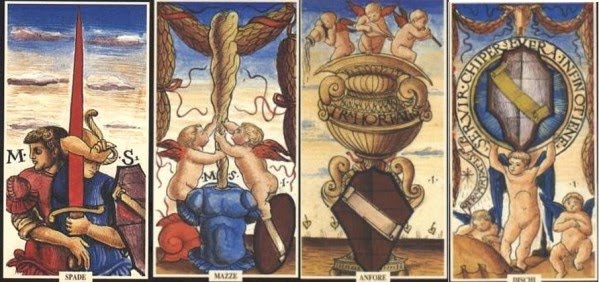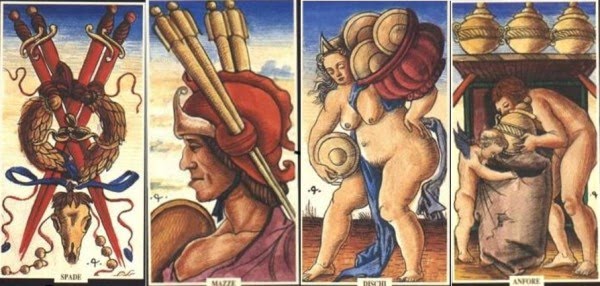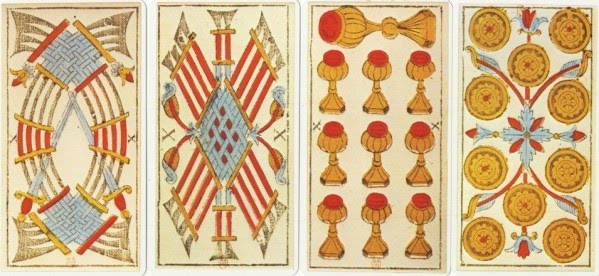There is also the question of the flowers and vines that slither among the suit-objects. I know that people--e.g. Jodorowsky, Way of Tarot--have developed ingenious interpretations of these arrangements, but I see very little that relates either to the Neopythagorean properties of the numbers, the SB pip designs, or any historical set of cartomantic interpretations, such as the "Etteilla." The flowers and vines look to me mostly like an attempt to fill in blank spaces in a pleasing way. The only meaningful exception might be the twos and the fours, as we shall see.
Now for the often tedious details.
THE MARSEILLE ACES
I have already discussed the “Marseille” aces, at the beginning of this essay, but now I want to go into more detail.
The Ace of Cups not only has a cup or chalice, but three splashes of liquid coming out of it (I give here the Conver of 1761, but others, back to Noblet of c. 1650, are similar). These three splashes could well correspond to the three putti on the SB Ace of Cups, and so equally well represent the Trinity as the three-in-one.


The Ace of Swords also has some correspondence to the SB Ace of Swords. If, as I see it, the SB Ace has a man and a woman, the “Marseille” image correspondingly has a phallic sword penetrating a vaginal crown. It is again the theme of the unity of opposites, the male-femaleness of the Neopythagorean Monad.
In the SB Ace of Coins, there are three putti, which I analyzed as the three members of the Trinity. In the "Marseille" Ace of Coins, as Jodorowsky points out in Way of Tarot, there are three circles. Here is his illustration showing the three (p. 278).

Both the three circles and the three putti might again represent the Trinity: in the "Marseille," the flower in the middle might be the Creator, the Sunlike jagged circle beyond that might be the Son, and the four vines might be the four gospels through which the Holy Spirit spread and continues to spread the Divine Word.
Another way in which the Conver Ace expresses the Monad is as the Sun, as de Mellet writes (http://tarotpedia.com/wiki/Recherches_sur_les_Tarots, Section III):
The Latin translates as "Image of Apollo's Light," according to J. Karlin in a note to her translation. A-pollo means in Greek, "not many," and is one of the Pythagorean names of the Monad.The One-eyed one or the Ace of Coins, Phoebe 'lampadis instar', devoted to Apollo.
For the Marseille Ace of Batons is not the “unity of sames” that I saw in the SB card's two identical putti. Jodorowsky sees a phallic club ending in a vaginal black ellipse at the top (Way of Tarot p. 273). Batons in the Milanese tradition have been the suit of fertility and sexuality ever since the Sforza, as can be seen by the "greensleeves" motif on the PMB court cards. Similarly the "Marseille" club is colored green. In the Noblet, there is a leaf sprouting from an otherwise dead-looking piece of wood. (I don't know why it isn't green, too.) This is a common Renaissance way of indicating the Resurrection (see my post at viewtopic.php?f=11&t=502&start=10#p6849). In both the Noblet and Conver versions of the "Marseille" design, the cuts in the wood are colored red. To me this suggests death, i.e. the crucifixion, conceived here as a lopping off of the extremities. There is a similar effect in the Hanged Man card (3rd from left below), where the cuts that trim the posts are colored red on the Conver. (In the Noblet they are red, yellow, and green, thereby muting the symbolism.)
 One
difference between the Noblet (the two at left above) and Conver Aces
is that in the Noblet, the club is surrounded by what look like
tear-drops falling downward. In the Conver, they are rays, pointing up.
It is as though Noblet wanted to convey the death-dealing aspect of
clubs and swords, while Conver wanted to suggest rebirth. Another
detail to the same effect is the green stems coming out of the crown as
(in both versions) an olive branch and the palm leaf of victory.
One
difference between the Noblet (the two at left above) and Conver Aces
is that in the Noblet, the club is surrounded by what look like
tear-drops falling downward. In the Conver, they are rays, pointing up.
It is as though Noblet wanted to convey the death-dealing aspect of
clubs and swords, while Conver wanted to suggest rebirth. Another
detail to the same effect is the green stems coming out of the crown as
(in both versions) an olive branch and the palm leaf of victory.THE MARSEILLE TWOS
In the Twos (below), the crossed-sticks pattern we saw in the SB Two of Batons occurs in the “Marseille” version as well. The way is barred to Paradise, I think both styles of card say. The message is clearer in the SB, with its forlorn-looking man looking off beyond the card. Here the Noblet has an interesting detail (above, far right): the two flowers, one going up and one going down, have the same slash marks as in the case of the Ace of Batons, except painted yellow. It is as though the batons not only barred the way, but created the division into two, Adam digging and Eve spinning, both in their own little worlds, a divinely imposed gap between them. Perhaps that is one reason for the card's reputation as the only evil card among the Batons. De Mellet says, in Section III:
Be that as it may, all the even-numbered Noblet Batons are done the same way, sometimes with the cuts a bright red.The two alone, in which the batons are the color of red, seems consecrated to evil fortune.


For the remaining pips, I see no important differences between Noblet and Conver. To simplify my presentation, I will illustrate my points with just one of them, the Conver. For reference, I will continue to include the corresponding SB cards. (Here I am using the SB images that were painted in the 20th century and used in the commercially available deck. I had them already prepared in sets of four before I learned about the historical images on Tarotpedia. These are not the SB of history, I know, but in most cases the differences are inconsequential. I include them for reference only. The historical images are in my previous posts.)
In Swords, the two swords embrace at the top and bottom. It is a card of friendship like the SB card, a "unity of sames" across the two sides of the card, corresponding to the two sides of life in the SB, youth and age.
In Cups, we have two cups side by side. The Dyad is an act of separation from the Monad, resulting in two distinct beings. What is missing is the longing for the original unity that we see in the SB Two's cherub. In the Conver they are together.
In Coins, the belt connecting the two coins is much like the chain connecting the two medallions in the SB card. De Mellet, in Section IV of his essay, says that this card was called “the belt of Isis.” The Two of Cups was also consecrated to Isis, de Mellet says (Section II). The Ace, as Neopythagorean creator god, fits de Mellet's description of Osiris: "le Dieu générateur," the generator god (in section I of his essay). It is then the doctrine of male = odd, female = even, as described in numerous Neopythagorean texts (e.g. Macrobius, Commentary on the Dream of Scipio, trans. Stahl, p. 99). Presumably the Three would be Horus, the son of Isis and Osiris, to complete the Greco-Egyptian trinity (as expounded by Plutarch in Of Isis and Osiris).
THE MARSEILLE THREES


In the Conver Threes, the triangular pattern, one above two in Cups and Coins, or one between two in Swords and Batons, again suggests the mother, the father, and their child: the Neopythagorean/Aristotelian enformed matter, or the Divine Child Jesus, Horus, etc. But there is no differentiation among the suits; the different ways the 2 + 1 is represented are just a function of the how the different suit-objects are shaped. And there is no explicit representation of the child as in the SB Batons and Coins.


THE MARSEILLE FOURS
In the Fours, the "Marseille's" arrangements of the suit objects all exploit the fourness of the corners of the cards. It is the four directions, the four winds, the four evangelists (as on the World card), etc., as signifying a whole of some kind. That something is in the middle, a plant or coat of arms, might suggest that something is missing, something that will manifest in the fives: the element of soul.


THE MARSEILLE FIVES
The Conver Fives might perhaps be representing this missing element, soul, as the middle suit-object surrounded by the four arranged as before; but there are no further clues or any differentiation among suits, such as the SB has abundantly.


The Conver Sixes are each grouped as three groups of two, or two groups of three. The Theology explains that in being 3 x 2 and 2 x 3, the Hexad, like the Triad, designates the process of beginning, middle, and end. In the SB and the "Etteilla" word lists, this sequence was expressed in the sixes as the past, present, and future of the animal soul. We get nothing like that in Conver.
THE MARSEILLE SEVENS

 The
Conver Sevens show 6 + 1 or 3 +4. The first has no straightforward
Neopythagorean significance. The second does have meaning in
Neopythagoreanism: it is the three parts of the soul plus the four
cardinal virtues, the Theology of Arithmetic
tells us (p. 100), and also the two sides of the triangle at right
angles to each other in the Pythagorean Theorem (p. 87). But these
references are irrelevant to the tradition of the "seven ages of man"
that I see reflected in the SB and irrelevant to the "Etteilla" word
lists. It is also irrelevant to the "critical time" aspect of the seven
that is expressed in the SB and "Etteilla" Eight of Swords.
The
Conver Sevens show 6 + 1 or 3 +4. The first has no straightforward
Neopythagorean significance. The second does have meaning in
Neopythagoreanism: it is the three parts of the soul plus the four
cardinal virtues, the Theology of Arithmetic
tells us (p. 100), and also the two sides of the triangle at right
angles to each other in the Pythagorean Theorem (p. 87). But these
references are irrelevant to the tradition of the "seven ages of man"
that I see reflected in the SB and irrelevant to the "Etteilla" word
lists. It is also irrelevant to the "critical time" aspect of the seven
that is expressed in the SB and "Etteilla" Eight of Swords.THE MARSEILLE EIGHTS

 The
TheThe Conver Eights show two groups of four, or four groups of two. This relates to the concept of Justice as equality on both parts of a scales, and the same for its parts (2 and 2), and its parts (1 and 1), a concept expounded by Macrobius (Commentary p. 98). It relates to the Conver eighth trump, but not to the Theology's exposition of the Ogdoad, the SB Eight, or the corresponding "Etteilla" word list.
THE MARSEILLE NINES


The Conver Nines show 8 + 1 in three suits, while Cups is three groups of three. 8 + 1 has the Neopythagorean significance of the leap beyond the cosmos into the unknown beyond. 3 x 3 has to do with the Curetes (Theology p. 107) or the pseudo-Dionysian choirs of angels, again going beyond the cosmos. This result is consistent with the meaning of the Ennead, even more than Cups in the SB and "Etteilla," where the meaning is simply that of success in one's undertaking, like the juggling sea-creature. But in the Conver there is again no differentiation in meaning among suits.
THE MARSEILLE TENS


Two of the Conver Tens, Swords and Batons, are grouped as 8 + 2; Coins is 5 + 5, and Cups is 9 + 1. Although the first of these combinations appears in the SB Ten of Batons and Cups as well, it has no particular Neopythagorean significance as such; nor does this combination play a role in the interpretation of the SB Tens. 9 + 1 is the completion of the sequence, seen also in the SB Swords and Coins. But it takes the pictorial details to relate these cards to Neopythagoreanism in a way that is cartomantically significant. 5 + 5 is the same as 5 x 2, which the Theology finds significant:
But why this statement is significant is not said. Perhaps it makes 10 one of the "male-female" numbers, as containing both odd (male) and even (female), and thus like the Monad, to which we are returning.The decad is potentially generated by the even and odd, for 10 is five times two. (p. 114)
In summary, we can say neither that the pip arrangements in the "Marseille" style design have no relationship to a cartomantic tradition such as that suggested by the SB pips and the "Etteilla" word-lists, nor that it has a close relationship to such a tradition. Since the cards were primarily used in a trick-taking game, the deciding factor in determining these abstract designs was probably what looked good in a rectangular layout.
No comments:
Post a Comment